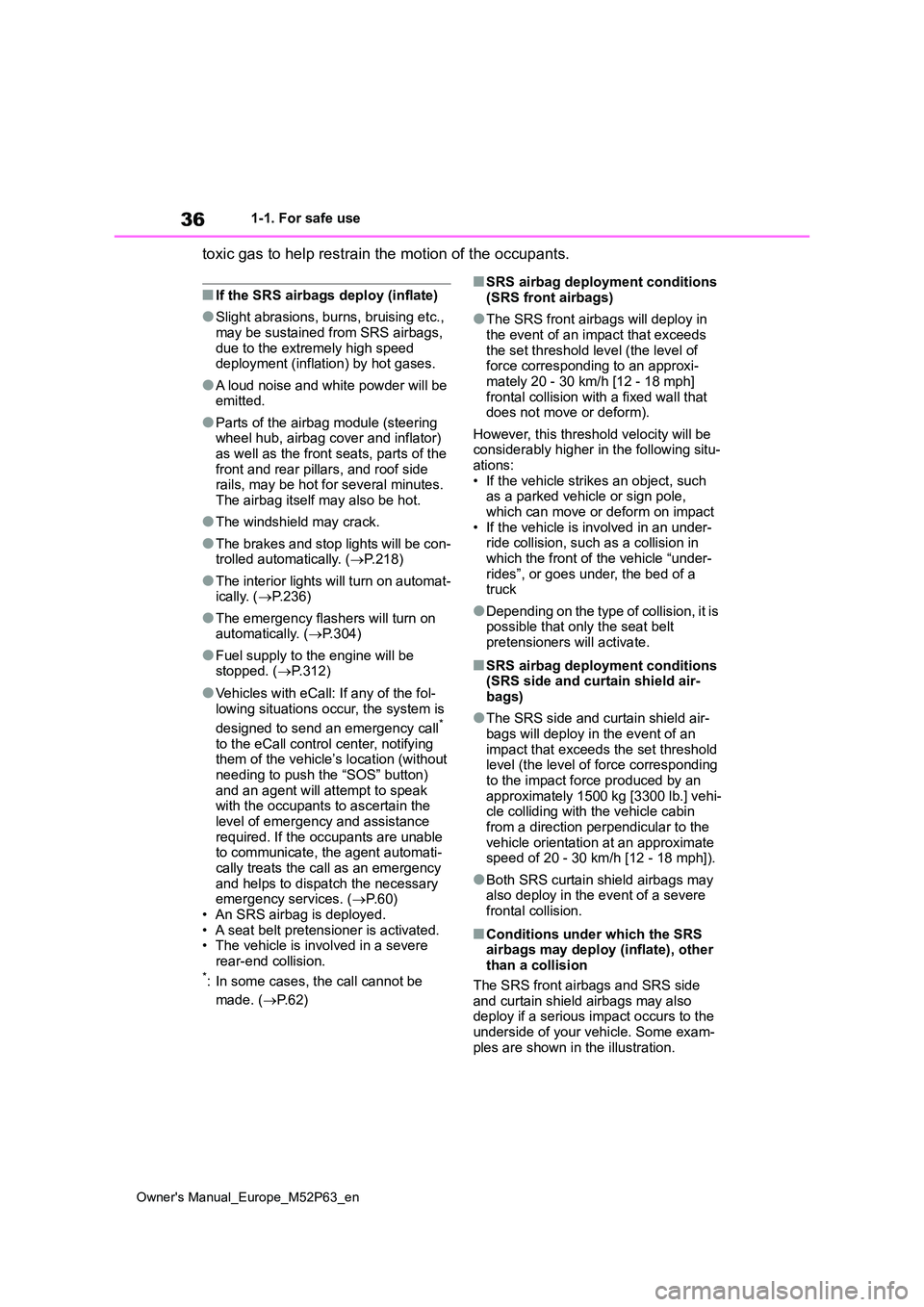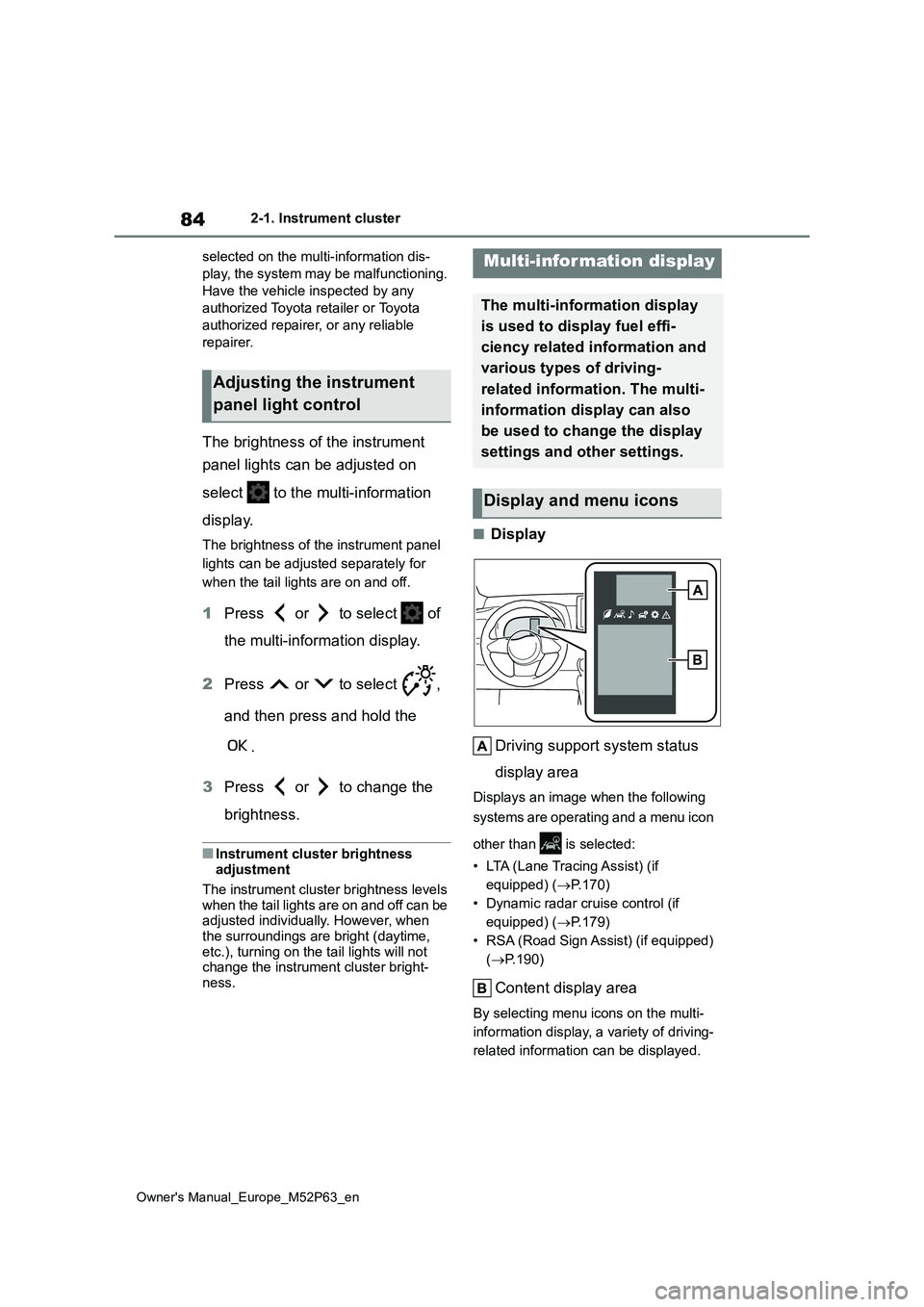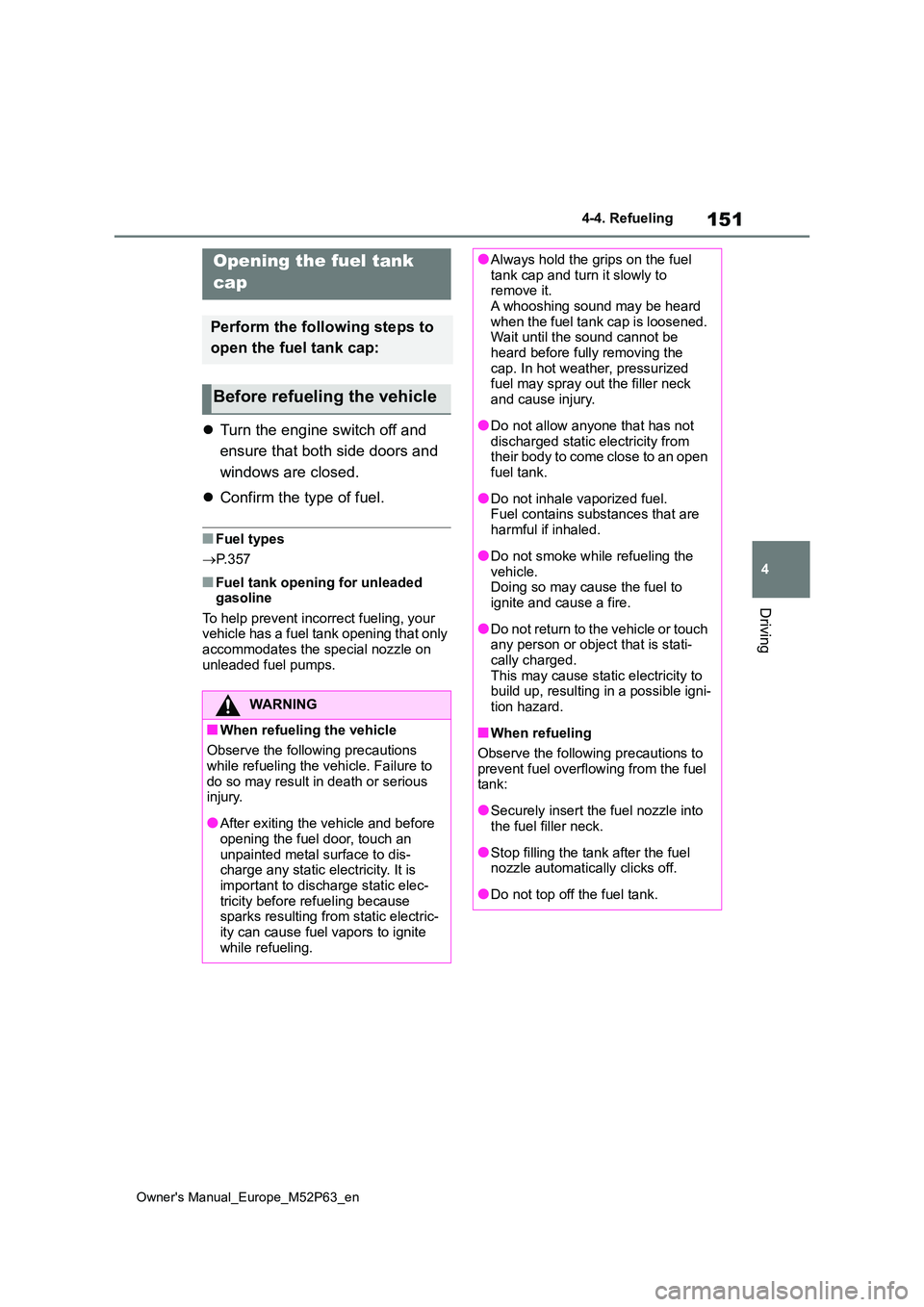2022 TOYOTA GR YARIS fuel type
[x] Cancel search: fuel typePage 15 of 470

13
Owner's Manual_Europe_M52P63_en
Pictorial index
Refueling method .............................................................................P.152
Fuel type/fuel tank capacity ................................... ..........................P.350
Tires .......................................................... ......................................P.275
Tire size/inflation pressure ................................... ............................P.355
Winter tires/tire chains ....................................... ..............................P.224
Checking/rotation/tire pressure warning system ................. .............P.275
Coping with flat tires......................................... ................................P.323
Hood ........................................................... .....................................P.266
Opening ........................................................ ...................................P.266
Engine oil ..................................................... ....................................P.350
Coping with overheating ........................................ ..........................P.344
Headlights/front position lights/daytime running lights/turn si gnal
lights ......................................................... ..............................P.140, 142
Front fog lights............................................... ................................P.148
Tail lights/turn signal lights ................................. .................P.140, 142
Stop lights
Side turn signal lights ........................................ ...........................P.140
License plate light............................................ ..............................P.142
Rear fog light ................................................. .................................P.148
Back-up light
Shifting the shift position to R ............................... ...........................P.137
Light bulbs of the exterior lights for driving
(Replacing method: P.299, Watts: P.355)
Page 38 of 470

36
Owner's Manual_Europe_M52P63_en
1-1. For safe use
toxic gas to help restrain the motion of the occupants.
■If the SRS airbags deploy (inflate)
●Slight abrasions, burns, bruising etc., may be sustained from SRS airbags,
due to the extremely high speed deployment (inflation) by hot gases.
●A loud noise and white powder will be emitted.
●Parts of the airbag module (steering wheel hub, airbag cover and inflator) as well as the front seats, parts of the
front and rear pillars, and roof side rails, may be hot for several minutes. The airbag itself may also be hot.
●The windshield may crack.
●The brakes and stop lights will be con-trolled automatically. ( P.218)
●The interior lights will turn on automat- ically. ( P.236)
●The emergency flashers will turn on automatically. ( P.304)
●Fuel supply to the engine will be stopped. ( P.312)
●Vehicles with eCall: If any of the fol-
lowing situations occur, the system is
designed to send an emergency call*
to the eCall control center, notifying them of the vehicle’s location (without needing to push the “SOS” button)
and an agent will attempt to speak with the occupants to ascertain the
level of emergency and assistance required. If the occupants are unable to communicate, the agent automati-
cally treats the call as an emergency and helps to dispatch the necessary emergency services. ( P.60)
• An SRS airbag is deployed. • A seat belt pretensioner is activated.• The vehicle is involved in a severe
rear-end collision.*: In some cases, the call cannot be
made. ( P. 6 2 )
■SRS airbag deployment conditions
(SRS front airbags)
●The SRS front airbags will deploy in
the event of an impact that exceeds the set threshold level (the level of force corresponding to an approxi-
mately 20 - 30 km/h [12 - 18 mph] frontal collision with a fixed wall that does not move or deform).
However, this threshold velocity will be considerably higher in the following situ-
ations: • If the vehicle strikes an object, such as a parked vehicle or sign pole,
which can move or deform on impact • If the vehicle is involved in an under-ride collision, such as a collision in
which the front of the vehicle “under- rides”, or goes under, the bed of a truck
●Depending on the type of collision, it is possible that only the seat belt
pretensioners will activate.
■SRS airbag deployment conditions (SRS side and curtain shield air-bags)
●The SRS side and curtain shield air-bags will deploy in the event of an
impact that exceeds the set threshold level (the level of force corresponding to the impact force produced by an
approximately 1500 kg [3300 lb.] vehi- cle colliding with the vehicle cabin from a direction perpendicular to the
vehicle orientation at an approximate speed of 20 - 30 km/h [12 - 18 mph]).
●Both SRS curtain shield airbags may also deploy in the event of a severe frontal collision.
■Conditions under which the SRS airbags may deploy (inflate), other than a collision
The SRS front airbags and SRS side and curtain shield airbags may also deploy if a serious impact occurs to the
underside of your vehicle. Some exam- ples are shown in the illustration.
Page 86 of 470

84
Owner's Manual_Europe_M52P63_en
2-1. Instrument cluster
selected on the multi-information dis-
play, the system may be malfunctioning.
Have the vehicle inspected by any
authorized Toyota retailer or Toyota
authorized repairer, or any reliable
repairer.
The brightness of the instrument
panel lights can be adjusted on
select to the multi-information
display.
The brightness of the instrument panel
lights can be adjusted separately for
when the tail lights are on and off.
1 Press or to select of
the multi-information display.
2 Press or to select ,
and then press and hold the
.
3 Press or to change the
brightness.
■Instrument cluster brightness adjustment
The instrument cluster brightness levels when the tail lights are on and off can be adjusted individually. However, when
the surroundings are bright (daytime, etc.), turning on the tail lights will not change the instrument cluster bright-
ness.
■Display
Driving support system status
display area
Displays an image when the following
systems are operating and a menu icon
other than is selected:
• LTA (Lane Tracing Assist) (if
equipped) ( P.170)
• Dynamic radar cruise control (if
equipped) ( P.179)
• RSA (Road Sign Assist) (if equipped)
( P.190)
Content display area
By selecting menu icons on the multi-
information display, a variety of driving-
related information can be displayed.
Adjusting the instrument
panel light control
Multi-information display
The multi-information display
is used to display fuel effi-
ciency related information and
various types of driving-
related information. The multi-
information display can also
be used to change the display
settings and other settings.
Display and menu icons
Page 90 of 470

88
Owner's Manual_Europe_M52P63_en
2-1. Instrument cluster
■Boost Meter/Oil Temperature
Gauge/Oil Pressure Gauge
Boost Meter:
Displays the boost pressure. The
display changes colors when the
specified pressure is exceeded.
Oil Temperature Gauge:
Displays the temperature of the
engine oil. The display flashes
when the engine oil exceeds 140°C
(284°F).
Oil Pressure Gauge:
Displays the oil pressure for the
engine interior. A buzzer sounds
and warning message is displayed
when the oil pressure gets low.
( P.323)
Depending on the road conditions, tem-
perature, vehicle speed, etc., the actual
vehicle condition on the display screen
may differ.
Use the display screen as a reference.
■Meter display settings that can
be changed
Language
Select to change the language dis-
played.
Units
Select to change the units of measure
displayed.
• Fuel economy display
Select to change the average fuel con-
sumption display between after
start/after reset/after refuel. ( P.86)
(if equipped)
Select to display/not display the audio
system linked display.
Select to change the displayed content
of the following:
• Drive information type
Select to change the drive information
type display between after start/after
reset.
• Drive information items
Select to set the first and second items
of the drive information display to any of
the following: average vehicle
speed/distance/elapsed time.
Pop-up display
Select to enable/disable pop-up dis-
plays for each relevant system.
Multi-information display off
Select to turn the multi-information dis-
play off.
To turn the multi-information display on
again, press any of the following meter
control switches
//// /.
Default setting
Select to reset the meter display set-
tings to the default setting.
■Vehicle functions and settings
that can be changed
P. 3 5 9
■Suspension of the settings display
●Some settings cannot be changed while driving. When changing set-
tings, park the vehicle in a safe place.
Settings display
Page 129 of 470

127
4
Owner's Manual_Europe_M52P63_en
4-1. Before driving
Driving
head-up display (if equipped) while
the system is operating.
■Breaking in your new Toyota
To extend the life of the vehicle, observ- ing the following precautions is recom-
mended:
●For the first 300 km (186 miles):
Avoid sudden stops.
●For the first 1000 km (621 miles): • Do not drive at extremely high
speeds. • Avoid sudden acceleration.• Do not drive continuously in low
gears. • Do not drive at a constant speed for extended periods.
■Brake pads and discs
●The brake pads and discs are designed for use under high load con-
ditions. Therefore, brake noise may be generated depending on the vehi-cle speed, braking force and vehicle
environment (temperature, humidity, etc.).
●The brake pad is easy to be over dust, and life may be short.
●The brake pad may do stick to discs.
●Braking force may decrease by low
temperature, snow, water.
■Drum-in-disc type parking brake system
Your vehicle has a drum-in-disc type
parking brake system. This type of brake system needs bedding-down of the brake shoes periodically or when-
ever the parking brake shoes and/or drum are replaced. Have any authorized Toyota retailer or Toyota authorized
repairer, or any reliable repairer perform the bedding down operation.
■Operating your vehicle in a foreign country
Comply with the relevant vehicle regis- tration laws and confirm the availability of the correct fuel. ( P.350)
■Idling time before engine stop
To prevent damage to the turbocharger, allow the engine to idle immediately after high-load driving.
Driving conditionIdling time
Normal city driving or
high-speed driving (at
the high-way speed
limit or recommended
speed)
Not necessary
Steep hill driving, con-
tinuous driving (race
track driving etc.)
Approximately
1 minute
WARNING
Observe the following precautions. Failure to do so may result in death or
serious injury.
■When driving the vehicle
●Do not drive if you are unfamiliar with the location of the brake and accelerator pedals to avoid
depressing the wrong pedal.
• Accidentally depressing the accel-
erator pedal instead of the brake pedal will result in sudden accelera-tion that may lead to an accident.
• When backing up, you may twist your body around, leading to a diffi-
culty in operating the pedals. Make sure to operate the pedals properly.
• Make sure to keep a correct driving posture even when moving the vehicle only slightly. This allows you
to depress the brake and accelera- tor pedals properly.
• Depress the brake pedal using your right foot. Depressing the brake pedal using your left foot may delay
response in an emergency, result- ing in an accident.
Page 153 of 470

151
4
Owner's Manual_Europe_M52P63_en
4-4. Refueling
Driving
4-4.Refuelin g
Turn the engine switch off and
ensure that both side doors and
windows are closed.
Confirm the type of fuel.
■Fuel types
P. 3 5 7
■Fuel tank opening for unleaded gasoline
To help prevent incorrect fueling, your vehicle has a fuel tank opening that only accommodates the special nozzle on
unleaded fuel pumps.
Opening the fuel tank
cap
Perform the following steps to
open the fuel tank cap:
Before refueling the vehicle
WARNING
■When refueling the vehicle
Observe the following precautions
while refueling the vehicle. Failure to do so may result in death or serious injury.
●After exiting the vehicle and before opening the fuel door, touch an
unpainted metal surface to dis- charge any static electricity. It is important to discharge static elec-
tricity before refueling because sparks resulting from static electric-ity can cause fuel vapors to ignite
while refueling.
●Always hold the grips on the fuel tank cap and turn it slowly to remove it.
A whooshing sound may be heard when the fuel tank cap is loosened. Wait until the sound cannot be
heard before fully removing the cap. In hot weather, pressurized fuel may spray out the filler neck
and cause injury.
●Do not allow anyone that has not
discharged static electricity from their body to come close to an open fuel tank.
●Do not inhale vaporized fuel.Fuel contains substances that are
harmful if inhaled.
●Do not smoke while refueling the
vehicle. Doing so may cause the fuel to ignite and cause a fire.
●Do not return to the vehicle or touch any person or object that is stati-
cally charged. This may cause static electricity to build up, resulting in a possible igni-
tion hazard.
■When refueling
Observe the following precautions to prevent fuel overflowing from the fuel tank:
●Securely insert the fuel nozzle into the fuel filler neck.
●Stop filling the tank after the fuel nozzle automatically clicks off.
●Do not top off the fuel tank.
Page 219 of 470

217
4
Owner's Manual_Europe_M52P63_en
4-5. Using the driving support systems
Driving
authorized Toyota retailer or Toyota
authorized repairer, or any reliable repairer immediately.
■ABS (Anti-lock Brake System)
Helps to prevent wheel lock when
the brakes are applied suddenly, or
if the brakes are applied while driv-
ing on a slippery road surface
■Brake assist
Generates an increased level of
braking force after the brake pedal
is depressed when the system
detects a panic stop situation
■VSC (Vehicle Stability Control)
Helps the driver to control skidding
when swerving suddenly or turning
on slippery road surfaces.
■VSC+ (Vehicle Stability Con-
trol+)
Provides cooperative control of the
ABS, TRC, VSC and EPS.
Helps to maintain directional stabil-
ity when swerving on slippery road
surfaces by controlling steering per-
formance.
NOTICE
■To prevent the GPF system from
not operating properly
●Do not use fuel other than the spec- ified type
●Do not modify the exhaust pipes
Driving assist systems
To keep driving safety and per-
formance, the following sys-
tems operate automatically in
response to various driving sit-
uations. Be aware, however,
that these systems are supple-
mentary and should not be
relied upon too heavily when
operating the vehicle.
Summary of the driving
assist systems
Page 352 of 470

350
Owner's Manual_Europe_M52P63_en
8-1. Specifications
*: If unleaded gasoline with a Research Octane Number of 98 is not available,
unleaded gasoline with a Research Octane Number of 95 may be us ed with no
detriment to engine durability or driveability.
■Oil capacity (Drain and refill
[Reference*])
*: The engine oil capacity is a reference
quantity to be used when changing
the engine oil. Warm up and turn off
the engine, wait more than 8 minutes,
and check the oil level on the dip-
stick.
■Engine oil selection
Gasoline Engine
“Toyota Genuine Motor Oil” is used
in your Toyota vehicle. Toyota rec-
ommends the use of approved
“Toyota Genuine Motor Oil”.
Another motor oil of matching qual-
ity can also be used.
Oil grade:
API grade SN PLUS “Resource-
Conserving” or SP “Resource-Con-
serving”; or ILSAC GF-6A multi-
grade engine oil
Recommended viscosity (SAE):
SAE 0W-20
Fuel
Fuel type
When you find these types of fuel label at
the gas station, use only the fuel with one
of the following labels.
EU area:
Unleaded gasoline conforming to Euro-
pean standard EN228 only
Except EU area:
Unleaded gasoline only
Research Octane Number98 or higher*
Fuel tank capacity
(Reference)50.0 L (13.2 gal., 11.0 Imp. gal.)
Lubrication system
With filter4.3 L (4.5 qt., 3.7 Imp. qt.)
Without fil-
ter4.0 L (4.2 qt., 3.5 Imp. qt.)